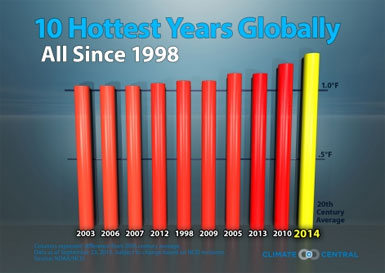For the first time, scientists say there’s little doubt that the warmest year on record by far – 2015 – and the string of warmest years before that – is the result of climate change.
No more "we can’t be sure, it’s only one year" or a string of years."
"We find that individual record years and the observed runs of record-setting temperatures were extremely unlikely to have occurred in the absence of human-caused climate change. These same record temperatures were, by contrast, quite likely to have occurred in the presence of anthropogenic climate forcing," concludes Michael Mann and others in a study published in Scientific Reports. Others concur.

All the major metereological organization across the world, including NASA and NOAA in the US, come to the same conclusion about 2015. "During 2015, the average temperature across global land and ocean surfaces was 1.62°F (0.90°C) above the 20th century average," says NOAA. 13 of the 15 hottest years on record have been since 2000.
While the media correlates it with El Niño, scientists say it is the opposite: It is rising greenhouse gases plus about a 10% contribution from El Niño.
Scientists expect 2016 will be warmer still.
If you get annoyed, as I do, when weather forecasters talk about the "unusual" and "crazy" weather without ever mentioning climate change, check out Weather Underground’s WXshift. It combines weather forecasts with local climate trends to help people understand how climate change affects them at the local level every day.
What caused the record snow storm this week on the East Coast?
Just for the record, this too is climate change – something that must be repeated to those who can’t believe global warming can cause snow.
The reason there is so much snow is that the Atlantic Ocean off the coast is "unusually warm" for this time of year, which translates into more moisture. When cold air collides with that warm, moist air, you get lots of snow.
Off the coast of North Carolina, for example, water temperatures are about 70°F right now.
That’s the part climate deniers seem to miss. So far, the majority of world emissions have been absorbed by our oceans, making them ever warmer (and acidic). The warmer they get all they need is a shot of cold to produce amounts of snow we’ve never seen before.
This year’s powerful El Nino may have had a role, but that too is stoked by warming – the Pacific Ocean, where El Nino forms, is also much warmer than ever before.
Another possible contributor is a slowing Atlantic Conveyor, commonly called the Gulf Stream, an "invisible river" that keeps temperatures moderate along the US east coast and all the way to the UK and Europe.
Flowing in two directions simultaneously, the Conveyor brings warm water from the equator northward, and cold water from Greenland southward.
Right now, the ocean around Greenland is "unusually cold," the exact pattern scientists expect to see as the Gulf Stream slows down – heated ocean waters remain along the southern US east coast instead of moving north, and cold water remains north, not moving to the south.
Direct measurements show the current has slowed over the past 10 years and scientists agree the Gulf Stream will eventually significantly slow or even stop, they just don’t know when it will happen. The system is the weakest in 1100 years, according to Germany’s Potsdam Institute for Climate Impact Research.

It really depends on how quickly Greenland melts. The faster it melts, the more likely the Gulf Stream will slow and even stop. "That’s because the overturning circulation is driven by cold, salty water sinking near the Arctic. As more fresh water from melting Greenland ice pours into the sea, it dilutes the seawater, making it less dense and thus less likely to sink," explains New Scientist.
If this long-term, scary trend happens sooner rather than later, getting two feet of snow will become commonplace, here and in northern Europe.
It would also lead to very rapid sea level rise as each year compounds the warmth in the oceans.
Check out how prepared your state is to handle climate change:
